RENEGADE GARDENER™
The lone voice of horticultural reason
Guide to Organic Gardening
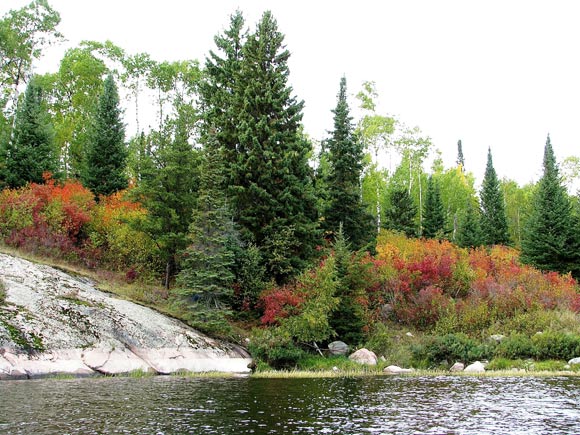 |
| Nature grows everything organically. |
04-10-14 – Soon we’ll be gardening again, some folks in warmer growing zones already witnessing the emergence of spring bulbs and perennials, while those of us here in the north will be waiting a wee bit longer for those soul-stirring first signs of spring (June?). Regardless, one thing all gardeners should be focusing on this year is being the best possible stewards of our private little patches of Earth.
Which is to say, be an organic gardener, which is to say, fewer and fewer gardeners have any idea of what the term means. Perhaps that’s not fair; many of us know what it means, we just don’t realize what it doesn’t mean.
The phrase “organic gardening,” has since its inception been coerced through the nursery industry/mass media/corporate shredder and emerged in spring, 2014 in somewhat unrecognizable form.
Let’s try to sort out the confusion. Our goal as gardeners, after all, is to be as neutral, even beneficial, to the environment as possible. This of course entails potential for falling prey to bits of the gardening industry’s eco-gobbledygook currently circling North America like the airborne spores of impatiens downy mildew, a pitfall that can do more harm than good.
Incorporating true organic gardening practices leads to healthier plants, less watering, less need for commercial fertilizers and other chemicals, and the best possible future course for the environment. Dig in:
Create Healthy Soil
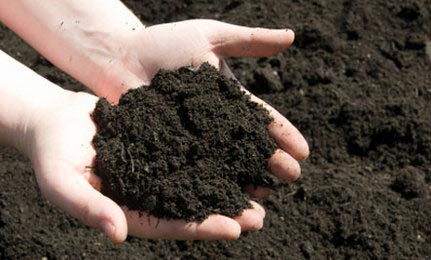 Well I recall one of my horticultural professors at the University of Minnesota beginning his lecture with the point-blank statement, “Eighty-five percent of the problems people have with growing anything relates back to their soil.”
Well I recall one of my horticultural professors at the University of Minnesota beginning his lecture with the point-blank statement, “Eighty-five percent of the problems people have with growing anything relates back to their soil.”
You need to create healthy gardening soil. It’s just like maintaining a proper diet of nutritious foods; one tends to feel better and avoid illnesses when one’s body is receiving the nutrients it needs in a form it approves of and naturally accepts.
So what is healthy soil? It’s a growing medium in the sixteen- to twenty-inch depth range consisting of a roughly equal combination of minerals (sand, silt, and clay) plus at least four percent organic matter. Organic matter in soil provides the following benefits:
- Nutrient Supply – The proper level of organic matter in soil provides plants with all the nutrients they need. “Feed the soil, not the plant” is clichéd, but it’s true. No one has circled each plant in the wilderness with a handful or two of commercial fertilizer. The prairie grasses flourish, the wildflowers bloom, and the pines grow straight and tall because the soil provides everything they need. Develop and maintain decent levels of organic matter in your soil, and you will never need to fertilize your plants. Repeat: You will never need to fertilize your plants.
- Water Retention – Organic matter in soil retains up to ninety percent of its weight in water. This water mixes with nutrients and is absorbed by plant roots as needed. Sandy soils drain so quickly, water isn’t often available to plants. Clay soils retain a lot of water, but the soil molecules are so tightly packed, they don’t release it readily to roots. Increasing the percent of organic matter in these types of soils greatly reduces the time spent and the amount of water used when watering.
- Soil Structure Aggregation – Soil structure is one of those final frontiers of agriculture and gardening that we’re just now getting a handle on. Organic matter causes soil to clump and form soil aggregates, an early stage in the establishment of natural soil structure. Natural soil structure can take several years to develop after the introduction of organic materials, which is why you rototill a bed once, to introduce the material, then never again.
Proper soil structure creates a harmonizing haven for soil microbes and earthworms with peak permeability (the gradual infiltration of water through soil). Organic matter content is what keeps soil from becoming compacted. This is why you don’t tromp around in wet garden beds in early spring. You are destroying the naturally occurring soil structure.
If you’re just starting out, pay for a proper laboratory soil test (it’s not much, fifteen to twenty-five bucks, usually) being sure to indicate that you want the lab to test for percentage of organic content. Contact your university county extension office.
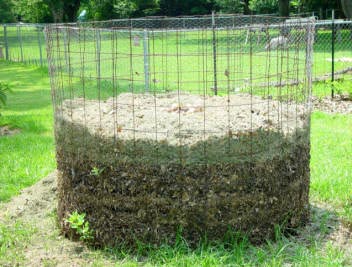
Compost is the easiest form of organic material to deal with, and is far superior to peat moss. Peat moss breaks down quickly into a final, very small percentage of organic matter. If you compost, great, having a cubic yard or two of black, sweet-smelling compost you make in your own bin(s) comes in handy. Mix a shovelful in with the soil you add around plants every time you plant a perennial or shrub.
Quite often, when dealing with poor soils such as clay (often plenty of nutrients, but lacking drainage and oxygen properties) or sand (bereft of nutrients and too proficient at drainage) you can’t make enough compost over a lifetime to amend the soil for a new garden bed, or major landscaping project. Find a supplier in your area – big nurseries, landscape supply yards, and in some cases your city works departments are the best places to start. You may well need yards of the stuff. Big truck rumbles up to your house, you write a check.
Even if results of a soil test show sufficient organic content, realize that organic matter levels in soil eventually deplete. Understand the difference between “organic materials” and “organic matter,” for that matter. Organic material is (generally) any living plant, animal manure or animal by-product. Composting is the process whereby organic materials are broken down via layering them in piles. The pile heats up and the materials break down into a loose and crumbly, soil-like additive called compost. Compost is organic material, but not yet organic matter.
“Organic matter” is composted organic material that has been introduced into the soil and further morphed into humus. Humus is the organic material that once in the soil has been converted by microorganisms to a resistant state of decomposition. It is stable in the soil, with only about five percent of the total percentage of organic matter mineralizing each gardening season. Organic material is what you add, organic matter is what it becomes.
So when I admonish readers to add “copious amounts” of organic material when amending poor soils, I mean it. You are not adding five percent compost to soils bereft of organic content. Compost will turn to humus – organic matter – with a depletion rate of up to ninety percent. You saw that big pile of leaves, dried grass clippings, deadheads, small twigs, kitchen scraps and last season’s annuals cook its way down to a pile of finished compost that was a quarter the volume of the original pile. Well, compost does same thing in your soil. It loses volume as it becomes organic matter.
Add fifty percent compost (organic material) to clay and sandy soils so that it results in a final organic matter content of four percent or more. I have never amended these kinds of poor, inert soils in either my own garden or a client’s where problems resulted later on due to amending the soil with too much compost. Four percent organic matter in soil is a minimum. Creating soils with organic matter content quite a bit higher than that is welcomed by most plants, with the exception of a small percentage of perennials, trees and shrubs that have evolved to survive in sandy and rocky soils low in organic matter. You typically are not growing these plants. If you are, you know more about soil than do I.
For you clay-dwellers, here’s a link to an article from the site written seven years ago just for you. Reading it through just now I note one instance where I use the term “organic matter” when I more properly meant “organic material.” And probably in other articles on the site. Ah well. So much to learn…
Mulching
To maintain healthy organic matter content in soil, mulch around plantings with organic material – compost, dried grass clippings, shredded leaves, pecan or cocoa bean husks, shredded hardwood bark. A two- to three-inch layer of organic mulch on top of the soil between plants blocks sunlight from germinating weed seeds, and greatly reduces water consumption by limiting the evaporation of water from soil. Mulching is as essential for vegetable gardens as ornamental landscapes.
Most important, organic mulch breaks down over time and replenishes the nutrients available to plants in the soil. Never lay down any form of plastic weed barrier or plain, black poli on top of soil, beneath the organic mulch. The weed barrier is a barrier all right – it halts the decomposition process whereby the mulch breaks down over a few years and is absorbed by the soil, thus replenishing and maintaining the organic content.
For clay, sandy or otherwise poor soils that you have amended with organic material, top-dressing with a one-inch layer of compost in late fall each season is the single greatest piece of gardening advice I can convey. If you have mulched these areas with some form of wood bark product, spread the compost right on top in late fall. Looks nice, darkens the mulched areas, and rainfall will filter it through where it will add an extra punch of nutrients to the wood bark as it decomposes.
Even if your property came with pretty good, black mineral soil containing four percent or more organic matter, top dressing growing areas with compost every few years is a splendid idea. Again, you probably can’t make enough compost. Big, rumbling truck. Checkbook.
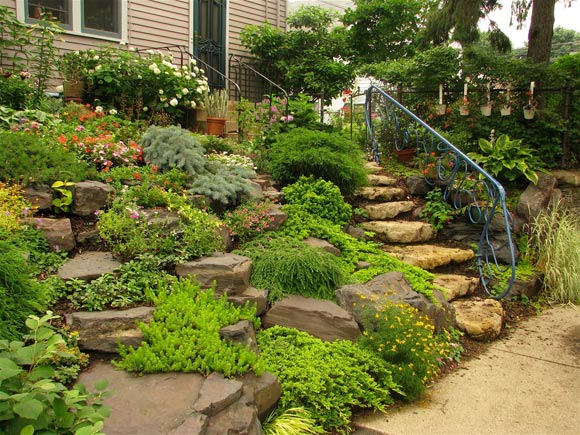
Diverse Plantings
There are reasons why commercial orchards and farm fields – whether organic or conventional – are sprayed regularly during the growing season with chemical fungicides and insecticides. Mass plantings of one type of plant offer harmful insects and funguses too easy a target.
“Good” bugs don’t know they’re good, and “bad” bugs don’t know they’re bad – they just think they’re bugs. Aphids are simply doing what they were created to do, suck the juices from preferred plants until they’re dead. The “good” and “bad” connotation is wholly in the minds of humans, based on our preference of plants. If along came a bug that sucked the juices out of dandelions or Canadian thistle, we’d call it a good bug.
But nature didn’t want a planet of dead plants, so it created bugs that prey on aphids, and other “bad” bugs. Syrphid flies, Minute Pirate Bugs, and Lady Beetles are just a few of the bugs that consider aphids a delectable feast. An important principle of organic gardening is to achieve, to the highest degree possible, a varied pallet of plant material that attracts a diverse contingent of both “good” and “bad” bugs. Let them battle it out.
Fungal problems are inevitable, but are avoided to great extent by good general gardening practices. Number one we’ve already covered: healthy soil. Fungal disease will be more prevalent in landscapes where plants are weakened by their attempts at growing in soil that is less than ideal, just as humans get stressed out from work, don’t get enough sleep, then succumb to a cold.
Allowing proper spacing between plants, particularly perennials, so air circulation is not compromised is another simple practice. It’s OK if perennials grow large and touch foliage in the portions seen from above, it’s more the spacing at the base and midway up, where you want good air circulation. Watering properly is also important. Water the ground and not the plant, and water early in the day so plant foliage up and down each plant that inevitably gets wet dries out as sunlight and temperatures increase during the day.
Divide your perennials when they need it. We divide perennials because they grow too large for their allotted space, and we want to make three plants from one, but the oft forgotten benefit of dividing our perennials every three years or so is to keep plants from growing too close together, thus limiting air circulation and abetting fungal disease.
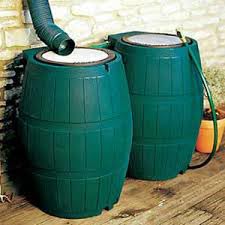 Harbor Sustainability
Harbor Sustainability
My definition of sustainability as it relates to gardening and landscaping is pretty simple: Managing built landscapes by reducing the use of natural resources and decreasing the amount of inputs and outputs from the landscape.
Meaning it goes hand-in-hand with good organic gardening practices. The goal is to create a landscape that limits the consumption or degradation of natural resources – air, water, soil – while not adding components that adversely affect the environment.
I keep it simple because the term is already being muddled (remember, there’s money to be made). Here are some key components to creating a sustainable landscape:
- Rain Barrels – These are a no-brainer. Collecting rainwater from your roof and using it to water your plants is something every homeowner should do, even in areas (Minnesota) where potential water shortages are the furthest thing from our minds. Remember, snide guys like me will point out that purchasing a plastic rain barrel or barrels, even if constructed from recycled materials, is an input that involved fossil-fuel based energy to manufacture, and transport. But that quickly is negated by the fact that you’ll be recycling rainwater, water that is better for plants than well water or that from a municipality.
- Limit Lawn – I’m not one of these total anti-lawn people; lawns have both an aesthetic and utilitarian function. Lawn creates a smooth, flowing patch of rich green, and I’ll design a landscape that uses some lawn space to provide balance, and open up the view so that portions of the landscape are presented without having to stand on a ladder and peer over a bunch of shrubs.
- Lawns are also important for safe child’s play and there’s nothing wrong with that. Lawns are not a complete ecological travesty, either. They’re fabulous for cleansing rain of pollutants and unmatched for curtailing erosion. It’s landscapes containing excess lawn that we need to rethink. The amounts of water, chemicals, and gas-powered equipment necessary to maintain what we consider a “healthy” lawn are ridiculous.
If lawn is a necessary part of your landscape, keep it as small as fits the need. Consider a low-maintenance lawn (Google the term) and develop a lawn that requires far less fertilizer and water. If necessary, use organic chemical fertilizers and weed control products, while realizing that you are indeed applying chemicals (more on that in a bit). - Reduce Fossil Fuel Use – A small lawn can be mowed easily with any of the spiffy new push mowers that have come back to market in recent years, as people become aware of the gasoline consumption and air pollution caused by power mowers. In general, garden more and go Vroom-Vroom less. Pulling weeds by hand may take longer, but is far more sustainable than spraying them with chemical herbicides. Incorporating compost into the soil takes longer by turning the soil with a shovel or spading fork versus running a gas-powered rototiller, but it’s also better exercise and creates no outputs.
- Plant Trees – Still one of the best things you can do for the planet. Trees act as air purifiers, reducing pollution levels by absorbing carbon dioxide, removing and storing the carbon while releasing the cleansed oxygen back into the air. Shrubs do this also.
Use Organic Fertilizers
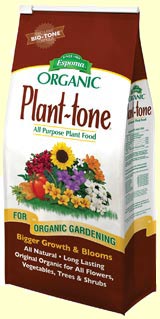 When fertilization is called for, the many forms of organic fertilizers available to gardeners are better for the soil and its microscopic inhabitants than their synthetic counterparts. Various brands of organic granular fertilizers (I swear by the Espoma brand, pictured) are available in various blends of nitrogen-phosphorus-potassium (N-P-K) levels to suit annuals, perennials, trees, shrubs and vegetables.
When fertilization is called for, the many forms of organic fertilizers available to gardeners are better for the soil and its microscopic inhabitants than their synthetic counterparts. Various brands of organic granular fertilizers (I swear by the Espoma brand, pictured) are available in various blends of nitrogen-phosphorus-potassium (N-P-K) levels to suit annuals, perennials, trees, shrubs and vegetables.
Fish emulsions are terrific, though sometimes odiferous. Organic fertilizers consisting of composted animal manures are also beneficial to plants while not disrupting the soil environment. Be aware that organic fertilizers are not as potent as synthetic fertilizers; a bag of organic granular fertilizer might contain an N-P-K of 3-4-5 versus a synthetic concoction containing 10-10-10. They also take longer – generally four weeks – to break down and become accessible to plants.
But that’s a good thing. Synthetic fertilizers – your bloom-blasting, water-soluble fertilizers featuring an N-P-K of 20-20-20, for instance – have been shown in university tests to greatly reduce the number of all-important microbes that exist naturally in soils. These populations do recover and grow back, but you knock them down again with your next application.
You also run a higher risk of burning plant roots through repeated use of synthetic fertilizers. It can be too much of a good thing, typically too much nitrogen and/or phosphorus, causing roots to become damaged and to shut down, weakening the plant. Organic fertilizers can be applied with little fear of root burn.
Another advantage to using organic fertilizers is that you are literally adding organic material to your soil, aiding in the development of organic matter content.
Tolerate Imperfection
Realize that your garden, your landscape, your property, is an ecosystem. Developing and maintaining good soil, recycling plant nutrients (compost), planting a diverse pallet of plants and choosing plants that match the cultural dictums of your property – sunlight exposure, soil pH, and soil type (even after amending, clay and sandy soils are still somewhat clay or sandy soils, though you’ve aided plant health quite a bit) are the keys to organic gardening.
Then learn to tolerate imperfection. Even in the wilderness, plants do not live perfect lives. I’ve hiked in wilderness areas and come across broad swaths of native plants – perennials, trees, shrubs – perfectly dead from a fungal or insect infestation. Nature does not judge this as either good or bad, but we do.
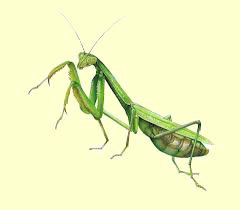 |
| Recognize the prize “good” bug: Praying Mantis |
You’ll always have bad bugs in a garden. If you create a proper, balanced ecosystem, their numbers will be kept in check by other bugs (and birds) that feast on them. They may cause limited damage that you can live with. Spraying aphids that have infested a plant with a sharp stream of water from your hose as needed, knocking them to the ground, is often enough to stop unacceptable levels of damage until their juice-sucking stage has passed. Larger bad bugs, such as European Pine Sawfly and Japanese Beetles, can be handpicked from their host plants and dropped into a bucket of soapy water.
Fungal disease occurs in nature, and will occur in your garden/landscape. Grow healthy plants, properly spaced, and in the right culture, and you’ll rarely be visited by any catastrophic level of fungal disease.
Yes, some fungi are more egregious than others – impatiens downy mildew is probably going to find and kill impatiens on your property even if you are the greatest organic gardener the world has ever known. It probably was present in the plants you or a neighbor brought home from the nursery, a big reason why impatiens are going to be given a timeout by the nursery industry for the next five to six years.
Now, the big question: What does an organic gardener do when an outbreak of pest insects or fungal disease turns the corner and heads into major infestation territory? When picking sawfly worms that are covering (and killing) every limb in a stand of thirty-foot pines is not possible? When aphids, wooly adelgids, Japanese beetles or other marauding pests are virtually destroying your landscape? Or powdery mildew is racing through the plants in your garden so quickly you see it expand virtually day by day?
Why, as an organic gardener, you reach for a wide array of approved, organic gardening products, of course. And here’s where we run into the gobbledygook.
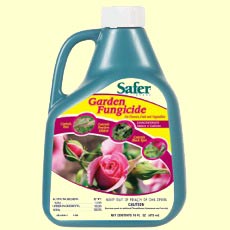 |
| Safer? For what? For whom? |
Limit the Use of Organic and Synthetic Chemicals
I’ve mentioned that organic gardening and sustainability go hand-in-hand. As gardeners, we want what’s best for the environment. This means understanding that when it comes to choosing a fungicide or insecticide to control a major outbreak of disease or destruction in your landscape, it’s not a choice between organic products and chemical products, it’s a choice between organic chemical products and synthetic chemical products.
Either way, you are always spraying a chemical!
A quick, but important history: Chemicals – both organic and synthetic – have played a primary role in sustaining human life on the planet. They are instrumental in protecting and expanding the world food supply. Ever heard of the Irish Potato Famine? Nature created a fungus that traveled from Mexico to Ireland, where during the summer of 1845, it turned Ireland’s entire potato crop into slimy, black, inedible mush balls.
Potatoes were an important staple of the Irish diet, and over the next ten years, over one million people died, including those in nearby countries also affected by the blight. There were no chemical treatments available to combat the fungus. In fact, since earliest recorded history, many millions have died from famine caused by fungi and predatory insects wiping out the human food supply in one region or another.
These horrors are virtually unknown to us today. There still are outbreaks, in the US and around the world, but their devastation is limited due to the advanced use of chemical controls. Without them, you wouldn’t be here.
The first chemical controls for agriculture involved the use of organic chemicals, broad use of which began in the mid-1800s. Then or today, what’s an organic chemical? The nerdly definition is a chemical derived from any physical source containing a carbon atom. The practical layman’s definition is that organic chemicals are derived from plants, animals, naturally occurring bacteria, or natural compounds found on Earth.
Lead and copper arsenate, and copper sulphate, were the primary organic chemicals manufactured in forms that could be mixed with water and sprayed on agricultural crops to control fungi and insects. The spraying of copper sulphate on plants and into the soil, in fact, is what finally ended the Irish Potato Famine and once again allowed farming of disease-free potatoes.
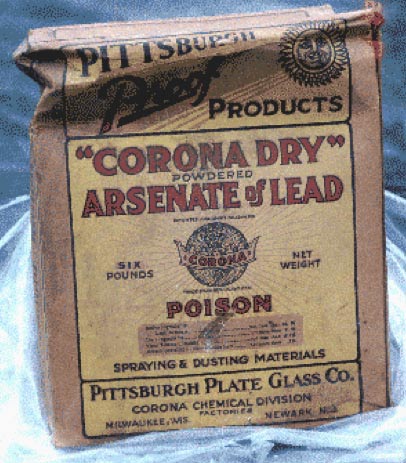 Copper sulphate and lead arsenate were the primary organic chemicals used in farming in the US and around the world to control fungal disease and insect infestation well into the 1950s. Problem was, these organic chemicals are extremely toxic to humans and animals, and indeed toxic to all forms of life, including fish, birds, insects and plants. Copper and lead-based insecticides and fungicides kept killing farmers and farmhands, and sickening populations exposed to heavy levels of copper and lead in the food supply. They were also hell on “good bugs,’ birds, fish, and particularly the soil.
Copper sulphate and lead arsenate were the primary organic chemicals used in farming in the US and around the world to control fungal disease and insect infestation well into the 1950s. Problem was, these organic chemicals are extremely toxic to humans and animals, and indeed toxic to all forms of life, including fish, birds, insects and plants. Copper and lead-based insecticides and fungicides kept killing farmers and farmhands, and sickening populations exposed to heavy levels of copper and lead in the food supply. They were also hell on “good bugs,’ birds, fish, and particularly the soil.
In addition, both lead and copper are extremely stable in soil, meaning that levels of these toxic compounds began to build up, contaminating the soil and leading to further growing problems. As the environmental dangers of these organic chemicals became understood (and insects and fungi developed immunities), scientists began developing synthetic chemicals. That’s a key point that some people never hear: Synthetic chemicals were developed because of the adverse effects organic chemicals were having on the environment and human health.
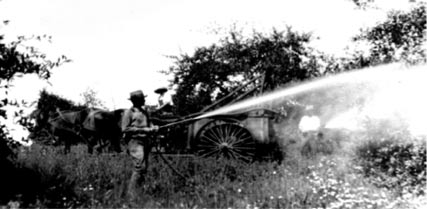 |
| Lead aresenate being sprayed to control insects in a Virginia orchard in the 1920s. |
What are synthetic chemicals? One of my guaranteed laugh lines when I speak in public is, “Synthetic chemicals are those chemicals created by evil white Republicans in lab coats.” In truth, synthetic chemicals are chemicals formed through human control of a chemical synthesis process. As a practical definition, synthetic chemicals are those created by humans (regardless of political view) not derived from organic compounds.
Which brings us back to your garden. In cases of major outbreaks of fungi or harmful insects, you may choose to spray a chemical control. After all, whether it’s powdery mildew or marauding insects destroying the plants in your landscape or your vegetable garden, it’s on the march across the country. It came from a neighbor’s yard, or is headed there.
Controlling it may well be ultimately beneficial. We’ve seen what the Emerald Ash Borer has done to millions of ash trees across America. That’s a bad bug that got out of control.
Just remember, whether you use an organic chemical gardening product or a synthetic chemical gardening product, you are always using a chemical. So here’s the important point: Some organic chemical products you’ll see on the nursery shelf are safer to use, and easier on the environment, than some synthetic chemical products, and vice versa.
That’s right. Some common synthetic chemical gardening products found on nursery shelves are more in keeping with sustainability – they’re safer for the environment – than their organic chemical counterparts. In other words, using a synthetic chemical product will sometimes cause less environmental harm than the product reading, “For Organic Gardening” on the label.
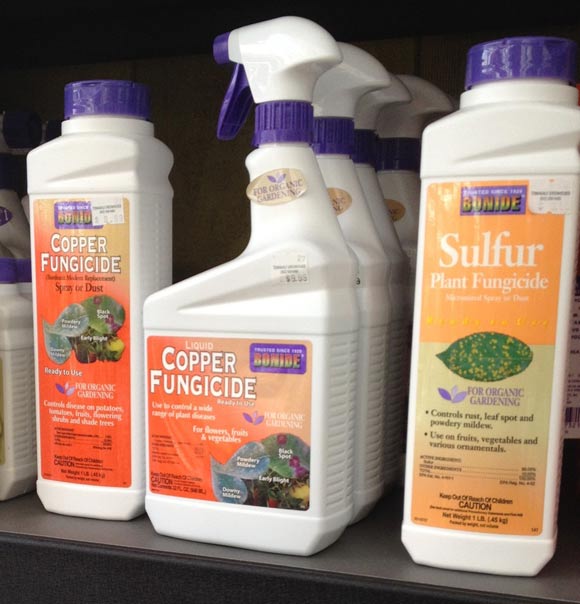 |
| It gets confusing. Here are two organic products you should never use. |
A case in point is the various copper-based fungicides (“For Organic Gardening”) you’ll see this spring on nursery shelves and in your box stores. Copper sulphate lives! And it’s the most dangerous, environmentally hazardous product in the store. Never buy it, never use it.
Base your decisions on a products’ “EIQ.” In 1992, Cornell University did the world a great favor by publishing the results of research in which scientists tested and evaluated the chemicals – organic and synthetic – used in agriculture and home gardening. Testing for toxicity to humans/mammals, insects, birds, fish, plus each chemical’s effects (and length of effect) on soil, bodies of water and groundwaters, we for the first time could evaluate the various levels of environmental impact caused by these chemicals.
On a scale, a number was assigned depicting the severity of environmental impact for each test chemical. Averaging the numbers across all tests for each chemical, the chemical was assigned a final number, now known as its Environmental Impact Quotient (EIQ).
University scientists with whom I collaborate on research suggest that gardeners use only organic chemical and synthetic chemical gardening products with an EIQ close to or below 20. Used according to label directions, these products have not only low environmental impact to the planet, there is no health risk to the user. “Negligible” is the common scientific term, meaning, you are not doing any lasting harm. Your body can shrug off a splash or a whiff, as can Mother Nature. (Mother Nature has bigger fish to fry – millions of years of volcanic eruptions, lava spills, meteor hits, and, in the last 10,000 years, unfettered forest fires.)
Copper sulphate fungicides have an EIQ of 47.8! Copper hydroxide fungicides are a bit better, EIQ of 33.3, but both are off the charts. So, as an organic gardener incorporating sustainable practices, if you must spray for fungal outbreaks, choose a much safer, synthetic chemical product, such as any containing the synthetic chemical fungicide captan. These have EIQs of 15.7.
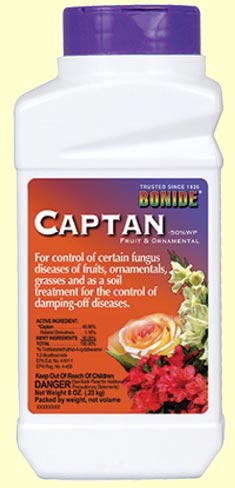 |
| Captan is one of the more environmentally healthy synthetic chemical fungicides. |
It’s also wise to stay away from any brand of sulfur-based organic fungicides. Right on the label, they list sulfur as the organic chemical ingredient. Sulfur has an EIQ of 32.6, plus doesn’t work as well as the synthetic captan. (One advantage of many synthetic chemicals is that they can be designed to do exactly one thing, in lower doses and fewer sprays. They also cost less to the consumer.)
Insect outbreaks? Use insecticidal soaps. These organic chemical-based sprays have a low EIQ (19.5) and work about as well on most insects as their synthetic chemical counterparts. The Safer® company sells a very effective insecticidal soap. Just be very careful around open water – insecticidal soaps are extremely toxic to fish and other forms of aquatic life. Remember, just because it says “soap” on the label, realize you are still spraying a chemical. Turn the spray bottle around in your hand, spray broadly across both open eyes, and after you return home from the emergency room, you’ll never forget.
One of the popular synthetic insecticide alternatives, carbaryl, sold as Sevin, has an EIQ of 20.9. The Ortho brand synthetic insecticides containing acephate run at an EIQ of 23.4. So the soaps are a wiser choice.
One of the most effective organic chemicals for combatting bad bugs is pyrethrin, a chemical derived from a few varieties of African daisies, with an EIQ of 18. It’s a nerve toxin proven to be very effective against insects and is often used in wasp sprays. Some pyrethrin-based insecticide brands include Garden Safe, Riptide and products by Bonide.
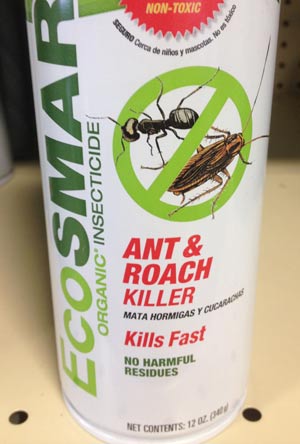 |
| I have to laugh at the eco-babble existing in the garden product industry. What do you mean, “Non-Toxic?” IT KILLS ANTS AND ROACHES. The only goal is to sell you a product, kids. |
Pyrethrin can be synthesized, that is, made in a laboratory, so you will also see synthetic chemical products listing “pyrethroids” as the active ingredient. Same chemical, with the same EIQ (18).
Always read the label to find the organic or synthetic chemical ingredient(s) used. No, EIQ listings are not given, for obvious reasons. Bonide and some of the other organic chemical insecticide manufacturers use pyrethrin and sulfur in combination, bumping their EIQ up past the level of their synthetic chemical counterparts. Still, it will say “For Organic Gardening” right on the label – the choice is yours.
A very wise choice is to use organic chemical products that list Bt (Bacillus Thuringiensis). This bacterium is found naturally in the soil and is very effective at insect control. You’ll find a number of insecticide brands using this chemical at your nursery, including a fine product manufactured by Bonide.
Bottom line, read every label before you allow a chemical gardening product into your ecosystem. Choose wisely between synthetic and organic chemicals, opting for the lowest EIQ, and trying to stay around or below 20.
An emerging problem noted at the university level is that consumers who purchase organic chemical products “For Organic Gardening” assume they aren’t using a toxic chemical. So they spray and spray, ignoring label directions, figuring if a little is good, more is better, and since it’s organic, it can’t harm the environment. Wrong. You are spraying a toxic chemical. If it weren’t toxic, it wouldn’t kill a fungus or insect.
I’ll conclude with an EIQ list of some of the most common chemical ingredients you will find on the labels of many common garden products:
| CHEMICAL | EIQ | TYPE | |
| Pyrethrin | 18.0 | Organic | |
| Pyrethroid | 18.0 | Synthetic | |
| Sodium/Potassium Salts (soaps) | 19.5 | Organic | |
| Petroleum Oil | 27.5 | Organic | |
| Carbaryl/Sevin | 20.9 | Synthetic | |
| Acephate/Orthene | 23.4 | Synthetic | |
| Copper Hydroxide | 33.3 | Organic | |
| Copper Sulphate | 47.8 | Organic | |
| Captan | 15.8 | Synthetic | |
| Bt | 13.3 | Organic | |
| Glyphosate/Roundup | 15.3 | Synthetic | |
| Neem OiL | 12.1 | Organic | |
| Sulfur | 32.6 | Organic | |
| Malathion | 23.8 | Synthetic | |
| Rotenone/Bonide | 33.0 | Organic |
Don Engebretson
The Renegade Gardener